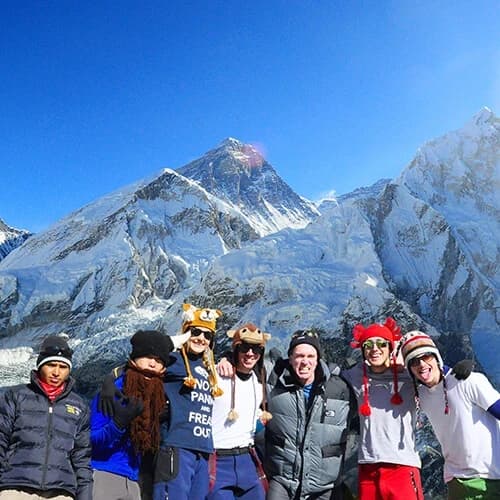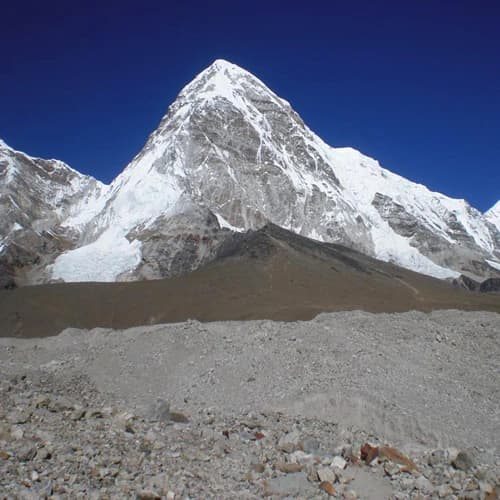Highlights of February Trekking to Everest Base Camp
- Breathtaking imagery of Mount Everest
- Picture-perfect sunrise and sunset views due to the clear skies
- Beautiful Himalayan countryside with snow everywhere
- More dining and accommodation options
- Increased accessibility of flights to Lukla
- Empty trails available for enjoyable hiking
- Celebrating February festivals with the neighborhood Sherpas
- A divine trekking adventure for ardent trekkers
How are the weather and temperature at Everest Base Camp in February?
The Everest region is located in the northernmost part of Nepal and part of the Hindu-Kush Himalayan landscape. Additionally, northern Nepal hosts some of the coldest temperatures throughout the year. To add more context, the Himalayas are notoriously famous for their challenging and unpredictable weather conditions. What is constant is the chilly weather with cold gushing winds throughout the year.
The snowfall rate is exceedingly high in winter, covering most of the trail with fresh snow all season. The air can get unbearably cold due to the influence of snow, but if you look up, you can also see the sun shining with its brightest rays. Although the environment is harsher than other seasons, it also feels comfortable in some ways. The fast, rugged lands in snow stretch as far as your eyes can see.
As the final winter month, February has mixed weather that settles to welcome the upcoming spring. The region that was harsh by the effects of cold winter slowly transforms toward warmer aesthetics. The sky is primarily cloudless, allowing you to stretch your eyes as far as they can see. Although it can get a bit windy, so, you must layer your clothing. All in all, February represents the welcoming of spring with a mix of spring-like conditions and a tang of winter aftereffects.
The temperature in the Everest region in February ranges between -15 degrees Celsius and 4 degrees Celsius. So, you must be cautious about what kind of clothing to pack. The daytime sunshine hours can last as long as 7 hours, and it is considerably warm on the trail, given the cold temperature. Starting mid-February, the weather becomes more generous. You might encounter snowy tracks along the route, so carrying some extra snow equipment like crampons is best. And, having an extra blanket or sleeping bag with you never goes to waste.
Why trekking to Everest Base Camp in February?
Since it is the off-season, there may be only a few compelling reasons to visit EBC in February for occasional hikers. However, it's the best month ever for avid trekkers. Here are a few benefits of a February hike to base camp if you're intrigued about the unadulterated beauty of nature and want to experience the thrill that so few dare.
Trekking on a peaceful trail
February is not a popular month for trekking in the Everest Region. So, the region is quiet compared to its famous counterparts. February is a perfect feat for you if you like to enjoy your journey by yourself with fewer people around. Few trekkers will be on the trail, and the mountain lodges will also host fewer travelers. This means you will get the best hospitality without struggle. Enjoy the empty trail with awesome scenery around you without the interference of any crowd.
Hassle-free Lukla flight tickets
As mentioned previously, February is an off-season trekking month. If you were to travel to Lukla during the peak seasons of spring and autumn, ticketing would be a struggle. February takes this struggle off of your trek. It is easier to get Lukla flights in February. The flight can even be emptier at times, which is never the case during the peak seasons. If you've ever been to Lukla in the spring or fall, you will understand the stress of booking tickets. Additionally, due to the morning's clear sky in February, there are fewer chances of a flight being canceled.
More than sufficient accommodation facility
In comparison to fall and spring, when it might be challenging to find your ideal accommodation in the Everest region, most teahouses and lodges will be quieter and have more available rooms to host guests in winter. The lodges and teahouses are overflowing with trekkers at the height of the hiking season. Since there will be few people there in February, you may also ask for more blankets, and they'll have enough to give you. The same is true for discounts on lodging and meals.
Crystal-clear views of the Himalayan glory
In February, you will witness bright and cloudless skies. This means you can enjoy the panoramic Himalayan splendor in its most magnificence. The Himalayas will be with you the entire way. They'll feel closer to you as you soar higher in the air. Those emotions you feel after witnessing such beauty cannot simply be described in words. You need to see it yourself.
Additionally, Tengboche's surrounding mountains are stunning and mesmerizing. You will get the best views from Tengboche! Several locations can only be fully appreciated in person because they are breathtakingly gorgeous and thrilling, and the EBC trekking route is one of them.
Celebrating February festivals
The Maha Shivaratri festival takes place in the month of Falgun (usually in February or March) and is one of the important celebrations in Nepal. Shivaratri, also known as "the night of Shiva," is a blessed day for Hindus, especially Shaivites (worshipers of Lord Shiva) who congregate at the well-known Pashupatinath Temple in Kathmandu. The celebration is something worth watching. Visitors can view the festival's magnificent displays, religious ceremonies, and cultural events. To enrich your cultural experience, you can schedule your trip focusing on Shivaratri.
What are the challenges of trekking to EBC in February?
Reaching Everest Base Camp on foot is a difficult journey in and of itself. It's especially challenging in February because of the consequences of the severely cold winter weather. On your February hike to EBC, you can run into the following challenges. Spend some time to learn about them so you can approach them effectively.
Heavy snowfall and blockade
At higher altitudes, you will come across places with substantial snow drifts. As a result, your route may require navigating through a lot of snow. The trails may also be covered in snow. Be sure to follow your guides' advice throughout this time. If not, you run the danger of being disoriented and losing your route. When walking in snowy circumstances, having a pair of crampons with you would also be preferable. Using crampons, you can anchor yourself to the snow and keep your balance. You might find it interesting that yaks lead the way during heavy snowfall without getting lost. They are the bulldozers of the Everest region.
Harsh winter and blizzards
You have to bear in mind that the weather is always unpredictable in the Everest region. And, in winter, even more so! One of the toughest challenges you'll face on your February trek to Everest Base Camp is a blizzard. Due to the frigid wind, the area around Mount Everest may encounter bad weather, such as blizzards. For extra safety, it is best to keep up with weather forecasts and to stay indoors when the weather is too harsh.
Getting stuck due to harsh weather
There might also be instances where you may have to spend longer than expected at a teahouse because the weather might not get any better. Safety is always important! Strategize your itinerary with some extra days if possible. That way, you will not feel disappointed if your February trek to Everest Base Camp takes longer than expected. And you don't have to worry about not making it in time for your return flight.
Solo Trekking is not worth it in February
You have to learn to make the most out of your trip. And trekking in February with the challenges of harsh weather conditions is a risqué ordeal. With snow covering the trails everywhere, there might be a possibility that you might even get lost. Furthermore, no one will be there to help you if things get wrong while trekking. So, having someone with you would help, be it a guide or a friend.
Likelihood of getting frostbite
In February, the Everest region experiences extreme cold. You must understand how crucial it is to get the appropriate hiking gear. Become accustomed to layering your clothes. It's essential to wear layers, especially at night. You should wear layers and cover your skin because, in Nepal, we do not have the practice of insulating indoors. Therefore, you need to adequately prepare to avoid getting frostbite.
Is hiring guides and potters necessary for February Trek to EBC?
It is essential to hire a guide and a porter during a winter trekking trip. When traversing the Himalayas, a guide is quite valuable. They have spent a great deal of time trekking in the Himalayas and are experts on the trail and the area. They are similarly packed with information that will be useful while hiking. Most importantly, they also know what to do in an emergency, so you'll be safe even if things go wild. You must have a trekking guide with you when you trekking to Everest Base Camp in February.
Similarly, porters take care of your big backpacks. Due to more clothing, trekking gear, and other items, your essentials will weigh more in February. You don't want to be too exhausted to hike, do you? Hire a guide and a porter to make your arduous February trekking excursion a little more comfortable.
Tips for your Winter EBC Trek
- Check your travel insurance status. Make sure it is active and covers helicopter rescue and emergency evacuation.
- Set aside a few extra days. When the weather gets bad, you could get stuck in the mountains anytime.
- Pack crampons, hiking poles, heavy sleeping bags, down jackets, and other winter trekking gear. They are a lot more useful than you might think.
- Layering your clothing is crucial. Instead of wearing one really thick jacket, layer a few smaller pieces of wool clothing that you can take off during the day.
- Double-check all of your trekking gear. Before starting your hike, you can buy whatever items you might have forgotten in Kathmandu.
- Regardless of the cold weather, make sure you drink enough water. Instead of drinking ordinary water, you can experiment with ginger tea, garlic soup, or other drinks for a chance.
- Trek with a tour company that is reliable and trustworthy. In adverse situations, their expertise in the Himalayas will be beneficial. They also use trained porters and guides.
Packing list for EBC February Trek
Go through the list for a general sense of what to pack for an EBC winter trek. Please consult with your travel agency before deciding on your final packing list.
- Hiking shoes with sturdy soles
- Crampons
- Camp shoes (Sneakers and Sandals)
- Hiking poles
- Backpack and a day pack
- Thick sleeping bag
- Down jacket and pants
- Waterproof windcheater jacket and pants
- Trekking T-shirts
- Trekking pants
- Fleece jacket
- Thermal wear
- Extra clothes for layering
- Undergarments
- Woolen caps
- Gloves
- Thick socks
- Basic First Aid Kit
- Water bottles
- Guide Book with a Trail map
- Toiletries
- Moisturizer
- Sunscreen Cream
- Sun hat
- Scarf
- UV Sunglasses
- Protein bars
We sincerely hope that our blog has given you some new perspective on the February trek to Everest Base Camp. The winter trek to the Everest region is among the most thrilling adventures you can embark upon. February comes with its exciting adventures, along with some concerns! The best thing you could do before starting any hiking journey is to do your own study.
If you want to book the expedition with us, we'd be happy to help. You can expect a remarkable, secure, and enjoyable trekking journey in the Everest region, thanks to our team's skills and two decades of experience in the Himalayas.
We are available to you at all times. Contact us by Whatsapp at +977 9851137385 or by email at info@outfitternepal.com. I hope to see you shortly in Nepal.
Some Most Popular Treks




